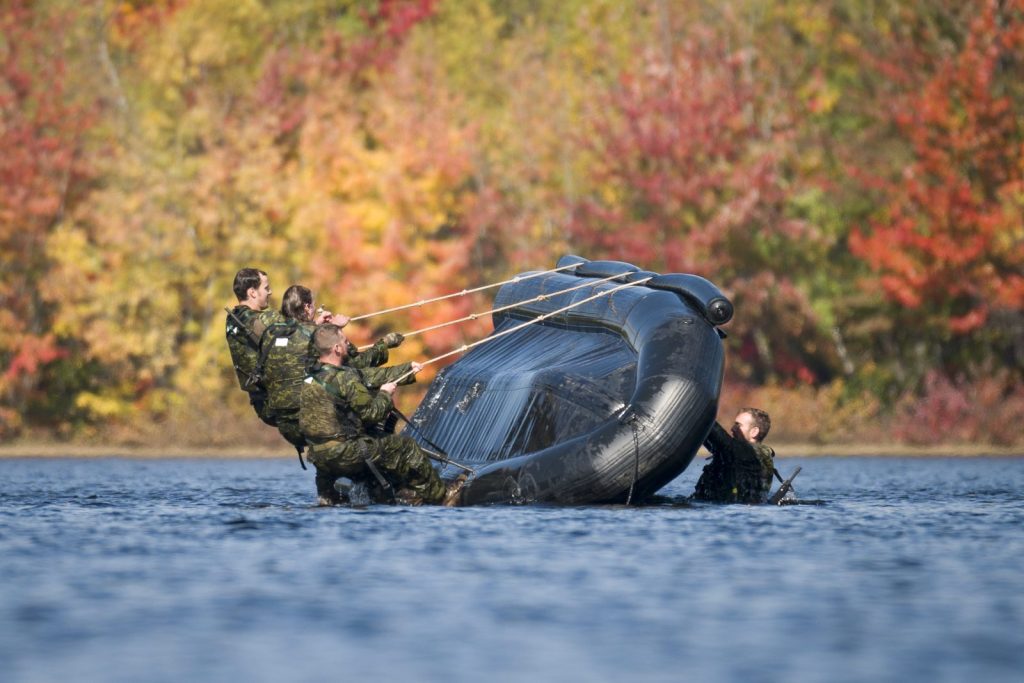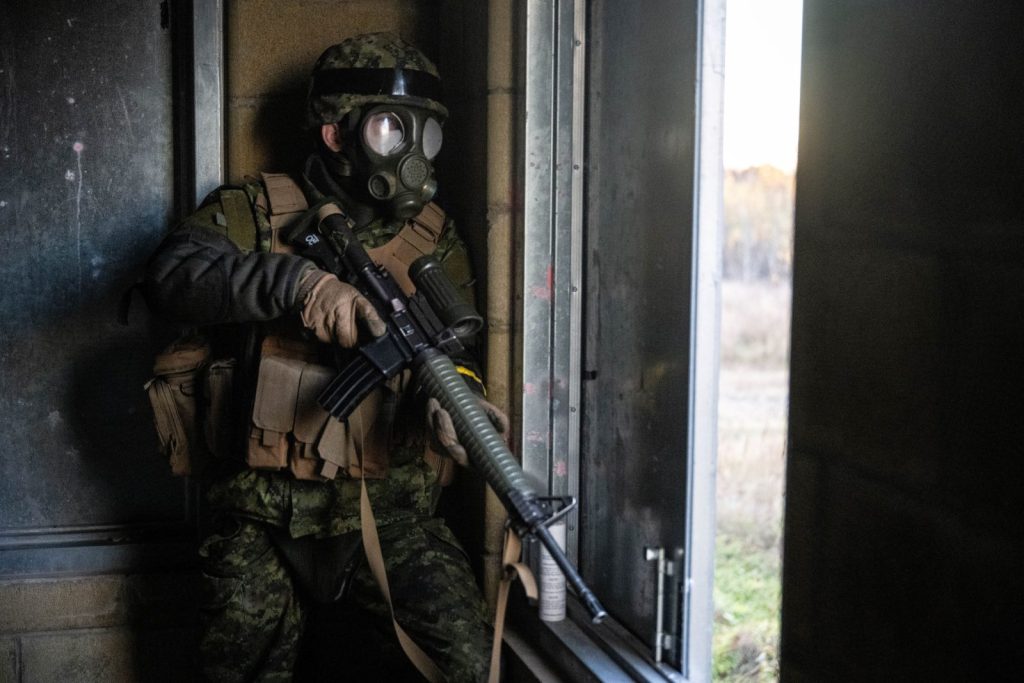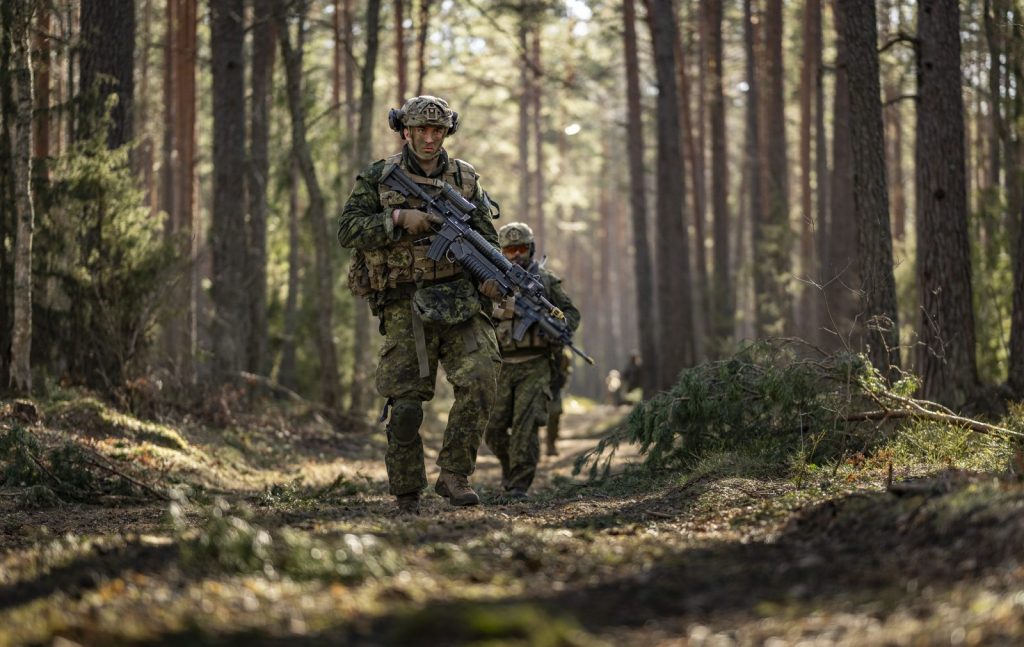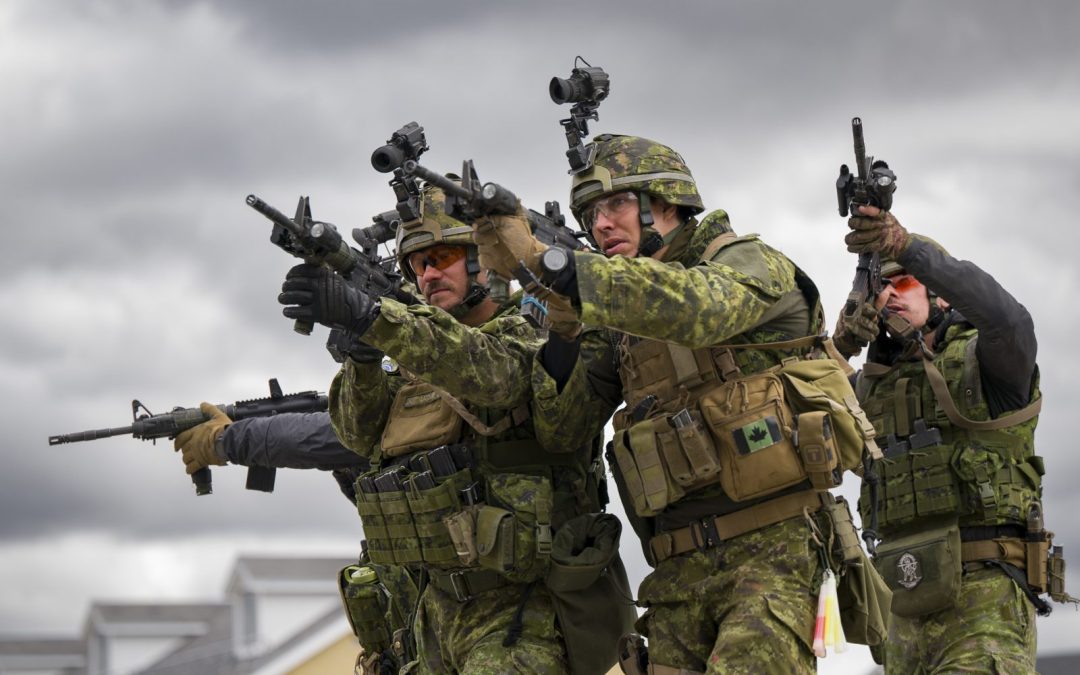by Chris Thatcher
With the standup of a Canadian-led multinational brigade in Latvia as of 2026, the Army is transforming how it validates brigade leadership and subunits for operations. The large collective training exercises of Unified Resolve, a computer-assisted command validation, and Maple Resolve, a live event confirming the command teams and capabilities of the battalions and other units, have run their course in their current form.
Instead, the Army will integrate into U.S. Army exercises and NATO Combat Readiness Evaluations in Latvia to confirm the brigade is ready for operations.
The Army’s training system is an ever-evolving machine, continuously capturing the lessons of current conflicts and the experiences of Canadian and allied formations to shape how it prepares soldiers individually and collectively for a spectrum of missions, from humanitarian and peacekeeping to counter-insurgency and conventional warfare.
The lessons of Ukraine have been especially stark, reinforcing the importance of long-range precision fires, concealment, and sustainment while adapting to the challenges of uncrewed aerial systems, loitering munitions, and advanced electronic warfare.
“The only way we can be on top of our game is to make sure we are updated and our doctrine, training, techniques, tactics and procedures are fully aligned to make sure we are ready for the next conflict,” said Major-General Roch Pelletier, commander of the Canadian Army Doctrine and Training Centre (CADTC).
The current changes to individual and collective training, however, are due more to resource constraints than emerging threats in eastern Europe, the Indo-Pacific, and elsewhere.
“We just don’t have the people,” Pelletier said candidly.
Ongoing recruitment and retention challenges across the Canadian Armed Forces have strained the availability of instructors and put pressure on the Army to minimize how often troops are away from garrison and family when they are on the verge of six-month or longer rotations to Latvia or other missions. Maple Resolve, especially, was an expensive training event, requiring the movement of hundreds of soldiers and heavy equipment across the country, and the sustainment of infrastructure to support the exercise.
“The training system is struggling with needing the equipment to train our soldiers,” Pelletier noted.
The Army might have “an outstanding training system,” built for purpose to prepare leaders and troops for the next conflict, but between increasing costs and the scope of personnel and equipment committed to Latvia, it was no longer sustainable in its current format, he acknowledged.
“We can still maintain the effectiveness of our training system, the same standard, but we needed to look at how can we make it easier to sustain for the long run, considering the resources we currently have.”

Students on the Reconnaissance Operations Course in October 2023. Photo: Cpl Dave Michaud
COLLECTIVE VALIDATION
Essentially, the change to collective training removes some of the redundancy deliberately built into a division and mechanized brigade group’s high readiness cycle. Previously, troops were training at the unit/battle group level under the Canadian Manoeuvre Training Centre (CMTC) in Wainwright, and then conducted similar training in a coalition environment in Latvia.
As of this year, the brigade on the high readiness track will conduct training at the subunit, combined arms level near their own garrison, and complete the battle group level training and validation in Latvia.
“It is actually more realistic for the troops,” Pelletier noted. “All the enablers, tanks, fires, electronic warfare, as well as the different levels of command are there. We will train them in the environment in which they may need to fight.”
While there is some risk to shifting the final collective validation exercise to Eastern Europe, with a war between Russia and Ukraine on the doorstep, “right now we know we can assume that risk,” he said.
The brigade’s light infantry battalion, on standby for the year as the Army’s Global Response Task Force, will undergo its validation — in conjunction with a U.S. Army brigade — on a rotating basis at either the Joint Readiness Training Center (JRTC) in Louisiana or the Joint Pacific Multinational Readiness Center (JPMRC) in Alaska.
“They will be our high readiness force if we need to deploy troops quickly,” said Pelletier. “We need those troops to be agile at force projecting. By validating outside of the country, we are forcing them to do that — to practice all the administration and sustainment and movement as they would have to do going anywhere in the world. And those [U.S.] centres are high level, delivering some of the best training in the world because of the resources they have.”
The new approach to validation will mean a change in the deployment cycle. Where previously a brigade would complete its build year with Unified Resolve and Maple Resolve, and then adopt a contingency response posture for a year before deploying rotations for the battle group in Latvia, now the brigade will conduct its build year of unit training and then deploy for final confirmation. Its third year of the cycle will be committed to other missions such as training Ukrainian soldiers under Operation Unifier.
Exercise Unified Resolve (UR) has traditionally been the Army’s largest computer-assisted training event and served as a validation of the brigade headquarters and the command staff of key subunits. The Army is retaining the first two phases of UR, which involve professional development and mission planning, and are conducted in home garrison. For the final confirmation event, the brigade HQ will now participate in the U.S. Army Warfighter series, integrating as a brigade under a U.S. division headquarters.
“That is going to be a very demanding exercise for them,” said Pelletier, noting the American capacity to conduct exceptionally challenging training at the division level. “For that reason, we thought giving our brigades that opportunity before they go work in a NATO environment was the best possible training we could provide them.”

A member of 37 Canadian Brigade Group in an urban defence scenario during FallEx 2023. Photo: MCpl Stephanie Labossiere
INDIVIDUAL DEVELOPMENT
The pressures affecting collective training are equally pronounced for individual training (IT) at the Combat Training Centre (CTC). The Army’s schools for armour, artillery, infantry, electrical and mechanical engineering, military engineering, communications and electronics, and tactic skill development are all finding it harder to pull instructors from the field force to augment their resident staff when those same soldiers are required for global deployment. Equipment too is either in short supply or, in some cases, outdated.
Moreover, the training provided by Canadian soldiers to the Ukrainian Armed Forces on Op Unifier has shown that basic skills and a lot of information can be imparted in a relatively short timeframe and has prompted questions about how the Army approaches some of its IT.
“We built a Cadillac system and if we had all the resources, we would probably keep it the way it is,” said Pelletier. “But the training system is not self sufficient — we just don’t have enough instructors to provide all the individual training that we need. By integrating more simulation, more technology, we can maintain the same level of training but with less resources.”
As with collective training, the tactics, techniques, and procedures of IT change as equipment and technology change and the lessons of the Army and allies are observed, said Colonel Barbara Honig, commander of CTC and the Army’s IT authority.
Historically, the training system has prioritized certain skills and knowledge over others to meet mission requirements. A combat engineer by trade, she noted that wet gap crossing was suspended for a period during the Afghanistan mission as improvised explosive device detection, ordnance disposal, and high-risk search demanded attention.
But as the schools gradually digitalize administration, training plans, and courseware, and adopt distance and in-person online and computer-based learning modules, there is an opportunity “to accept some risk,” she said, and increase the pace of courses to lessen the time away from home garrison or, in the case of reservists, away from civilian jobs.
Using simulation, surveillance operators are learning equipment in two weeks rather than four, and with far more repetitions than a field exercise. Small uncrewed aircraft systems operators now have a completely online training package, rather than an in-person course. Engineers are mastering the art and science of bridge building using virtual reality. Arrange the pieces in the wrong order or misjudge the weight and the virtual bridge will collapse or tip. For students who might previously have had just a few opportunities to instruct others on where and how to place the heavy girders and other components, often in wet and muddy conditions, VR allows multiple repetitions and the ability to learn at their own pace.
The Royal Canadian Electrical and Mechanical Engineers (RCEME) School in Borden now uses an industry-developed bilingual apprentice program for its Rank Qualification (Private) vehicle technician training. Students can watch a video of a procedure and then practice on a civilian truck system before broaching a LAV.
Even the Combat Team Commanders Course, one of the pinnacle events for combined arms training, has decreased from a six-week program with the last three weeks in the field, to a two-week simulation-based course. But where candidates might get one or two repetitions in the field, they are now getting five or six as a commander in the simulation.
“The basics of being a combat team commander are being able to plan combined arms operations, deliver orders, and synchronize fires and movement,” said Pelletier. “This can all be done in simulation. And they learn much more from their mistakes and can improve through each iteration.”
Moving online has removed much of the friction of a live exercise, Honig acknowledged, but instructors have seen a significant improvement in skills like the type of obstacle breaching prominent in Ukraine. “In the sim, they can repeat those tasks in ways that would not happen in a live ex,” she said.
The Army already leans on the defence industry for some training packages, especially when new equipment is introduced. Some of the CTC schools have also partnered with civilian colleges for trade-specific instruction where there is overlap. But with several urgent operational requirement capabilities about to deliver in the next year, “we will need to do a lot of training in a short period of time to get equipment and capability to Latvia,” said Honig.
Rather than a brief train-the-trainer program that is standard for many defence companies when a new platform or system is delivered, “we have been talking about extending manufacturer training a bit longer into our training system,” she said.

Members of the battle group in Latvia during Ex Crystal Arrow in March 2024. Photo: MCple Genevieve Lapointe
MIX REACTIONS
With the Army’s ongoing recruitment struggles, the CTC schools are treating every candidate as a precious resource. Instead of the sink or swim approach of the past, instructors are more cognizant of how they engage with students and have adopted more of a mentor/coach style to their instruction.
The Army can’t afford high rates of attrition, Pelletier noted. “We have changed the total culture of the training system.”
The schools have not lowered their training standards, added Honig, but “we’re now trying to improve the success rate and give every candidate an opportunity to [progress].”
Reaction to the changes on some courses has been mixed, she acknowledged. “Not everything we have tried works. In some cases, we have cut too far and had to put stuff back in after feedback from the field force. When you take something out of the IT system, the requirement for the soldier to know that doesn’t go away. All you have done is transfer that work to the unit. We don’t always get the balance right. But trial and error is okay. I tell the schools, ‘If you’ve tried something and it didn’t work, adapt.’”
Some of the feedback, though, has been “phenomenal.” RCEME students have had especially high praise for the course changes, she said.
The schools are also giving credit for skills acquired in garrison, recognizing that not every soldier may need to take a specific course to advance. “It is case by case,” Pelletier said, “but if somebody has already performed a job as a platoon warrant officer in their unit, for instance, then maybe they don’t need to go on the course.”
The Army is also recognizing the experiential learning of reservists, reducing or foregoing some courses if a reservist already has those skills from their civilian jobs. In addition, courses are being modified into smaller modules, to be taken over several summers rather than in three months.
“It is easier to ask an employer for a two-week course,” Pelletier noted. “Then they can do these throughout the year, whenever they are available.”
Some of the Reserve training has been broken into primary and supplemental packages, depending on the trade. Minefield clearance, for example, will only be required for Reserve engineers who are about to deploy. Infantry may only receive training in heavier weapons if they are preparing for deployment.
“We’ll train everybody to the basic level, and then provide the advanced level when it’s time to deploy, which can mostly be done through experiential learning in the unit or through the Regular Force unit they will join for the deployment,” said Pelletier. “We are looking at opportunities to streamline and make sure we don’t duplicate training.”
While Reserve members might see noticeable changes to specific courses, the changes won’t diminish their overall training. In fact, CMTC is actively marketing the Wainwright training area and its fully instrumented urban operations village to Reserve units across the country, not just in 3rd Canadian Division.
The Army might be conducting its largest collective validation exercises elsewhere, “but Wainwright is not going away,” said Colonel Scott MacGregor, commander of CMTC. “We need to market CMTC more for people to use …. [and] the Reserves are starting to get after it as are our Regular Force brigades.”
Pelletier has heard concerns from some corners that, by reducing time in the field, the Army risks lowering its training standards. Like Honig, he insisted the optimization of resources may not be ideal, but it won’t weaken a well-regarded training system.
“We have to make the best possible decision for the organization, and the situation has changed,” he said. “We are adapting to the current environment, the current pressure on the CAF for recruiting and retention. We have to find a better way to deliver the same thing.”
And more may be coming. As the Army simulation authority, CADTC is developing a new simulation strategy to identify capability requirements and investment priorities to ensure the right balance and integration of live, virtual, and constructive training. “Without that, we cannot deliver the training,” he noted.

